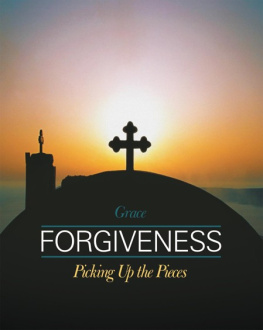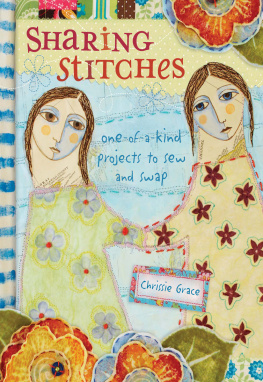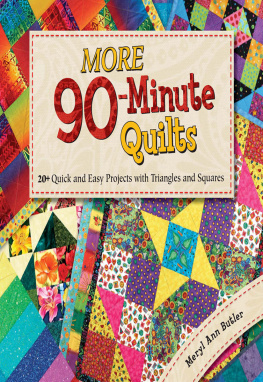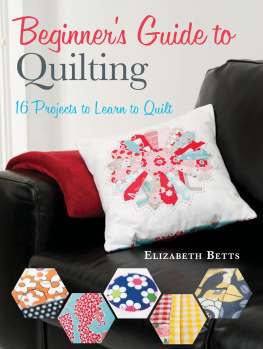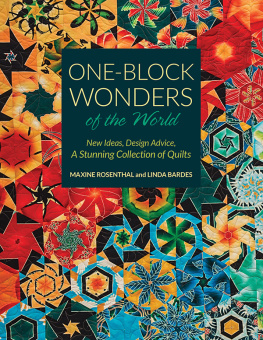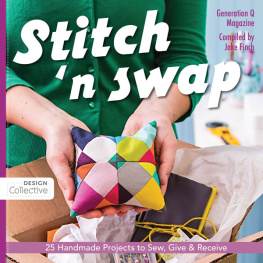Sew To Swap
Quilting Projects to Exchange Online and by Mail
Chrissie Grace


Introduction
Quilting may conjure up many different images for people. Many people associate quilts with scrap quilts made by women during the Great Depression. Another popular image is of grandmothers sitting together, hand quilting a gift during a weekly quilters bee. Ive always been drawn to the art of quilting, but when I discovered a group of modern quilters a few years ago, I was pulled into a whole new world that breaks many quilting stereotypes.
Modern quilting is a fresh approach to the traditional art of quilting. Modern quilters take traditional quilt blocks and update them in fresh and current ways. We also use modern fabrics, change up block arrangements and create our own quilt blocks. Many traditional quilt blocks have been modified by modern quilters, giving them a wonky, or skewed, look.
The word quilting refers to the stitches that hold the layers of a quilt together; modern quilters have a new view on this, as well. Straight-line quilting is popular for a clean look. Stippling and loopy quilting, or free motion quilting, have become popular techniques as well. While modern quilts reflect trends and current aesthetics, they also highlight the quilters personal style.
In October 2009 the founding branch of The Modern Quilt Guild began in Los Angeles. As of today, there are over 90 branches worldwide, and the groups are growing. Joining The Modern Quilt Guild, or any local guild, can provide you with support and education. In addition to things like workshops, field trips, charity quilts and show-n-tells, modern guilds often host fabric swaps and block swaps. Swapping is a very fun and exciting way to quilt.
I started participating in virtual swaps about a year ago and became hooked. While the projects in this book are geared for any kind of swapping group, I met these contributors online via blogs and swap groups. This book will give you a lot of information on virtual swapping, but please keep in mind that the swaps can be modified to fit a local swapping group as well.
Fabric swaps are perfect for beginning quilters who arent quite sure if their construction skills are ready to share with others. They are also a great way to collect a variety of fabrics. We tend to buy the same types of fabric for ourselves. Fabric swapping puts new fabrics into your collection, particularly pieces that you may not have purchased. Allowing someone elses taste to influence your fabric choices can help broaden your fabric collection, which in turn can add variety and interest to your quilt-making.
The spectrum of quilt block swapping is so large that I dont even know where to begin. The possibilities are limitless. You can swap with just one person and give each other a theme, such as a type of project, material specifications or a color scheme. You can swap small quilted projects or individual blocks. There are swaps for using leftover fabrics, swaps based on holidays, virtual quilting bees, quilt-alongs, swaps for charities, swaps for improv blocks and swaps based on colors or a trendy theme. The possibilities are endless, and once you get started, it will be hard to stop.
This book was written for those of you who are interested in becoming a quilt swapper. I hope you are inspired by the efforts of the participating quilters. The sheer talent, artistry and work contained in these quilts is overwhelming. The men and women who contributed to the swaps are all amazing quilters. Thank you to my quilting friends and fellow swappers who have taught me so much about the quilting world.
Enjoy the book!
A team of fabulous contributors helped make this book what it is. You will see their thoughts, hints and ideas throughout the book, and their handiwork in every project. For more information on these amazing quilters, see pages 137139.

Chapter One
Get Ready to Swap
If you picked up this book, chances are you are already a quilter or you want to become one. Even if youve never made a quilt, this chapter contains plenty of information to help you begin. Its important when constructing a quilt that you do it properlyit would be such a shame to spend your precious time and money constructing a quilted project only to have it fall apart later. If you are going to swap your handmade items, you want to send items of quality. Imagine how you would feel receiving an item that was put together poorly.
Becoming a quilt swapper takes you into a realm of quilting that will add a new dimension to your favorite hobby. You will create friendships with people who are interested in and support some of the same passions as you. You will be exposed to new projects, new techniques, new fabrics and new people that you would not otherwise have had the chance to experience. Whether you are a beginning, intermediate or advanced quilter, you are sure to learn new methods and techniques from your fellow swappers, and you will teach them new things, too, as you share your own personal style and way of doing things.
The bottom line here is to have fun! Enjoy the process, make some new friends and share what you love to do with others.
All About Swaps
You may be a modern quilter who is wondering, Why swap? As youll soon discover, there are many benefits to becoming part of a quilt exchange.
Perhaps most importantly, you will develop new friendships. When you participate in a swap, you spend your time and creative energies making something special for someone else, and in return they do the same for you. In doing so, you form a camaraderie through the act of creating. Swapping is also very educational. You will learn more about current fabric trends, popular block patterns and trendy quilted home dcor than if you were just sewing for yourself. Lastly, you will be filled with constant inspiration. It is just plain fun to receive what I call quilty mail. Quilt swappers tend to go all out with their swapping packages. Dont be surprised if you get little extras in your packages like a quilted pin cushion or a package of scraps. There is endless eye candy in the swapping world!

Types of Swaps
There are three main types of swaps. They can be
categorized as centralized, decentralized and quilting bees. These swaps differ by the methods used to get items from one quilter to another. They are all great ways to swap, but you may prefer one over the other.
Centralized Quilting Swaps
In this type of swap, participating swappers send their completed items (i.e., blocks) back to the leader of the swap. The swap leader sorts the items, repackages them and mails them back out to the participants. A good example of a centralized swap is T HE I NVISIBLE N INE P ATCH S WAP (page 108).
Pros for Centralized Swaps
- You receive all of your items at once.




